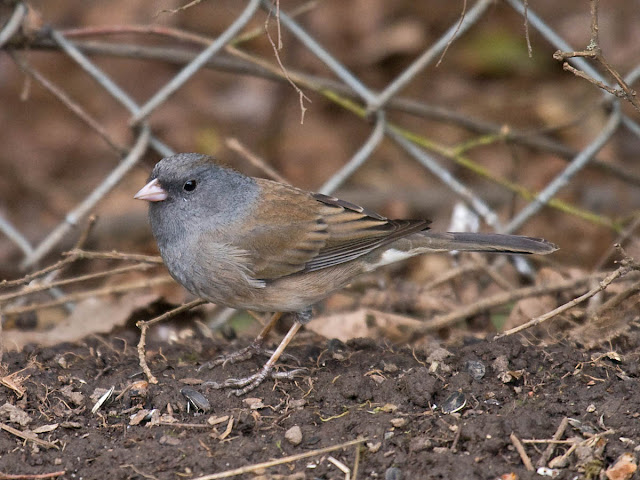 Gadwall, Portland, Oregon, 19 February 2011 by Greg Gillson.
Gadwall, Portland, Oregon, 19 February 2011 by Greg Gillson.Though not colorful, the drake Gadwall is exquisitely patterned.
See a previous post on Gadwall.
Enjoying and learning about birds in British Columbia, Washington, Idaho, Oregon, and northern California
 Gadwall, Portland, Oregon, 19 February 2011 by Greg Gillson.
Gadwall, Portland, Oregon, 19 February 2011 by Greg Gillson. Townsend's Warbler, Beaverton, Oregon, 22 January 2011 by Greg Gillson.
Townsend's Warbler, Beaverton, Oregon, 22 January 2011 by Greg Gillson. Townsend's Warbler, Beaverton, Oregon, 22 January 2011 by Greg Gillson.
Townsend's Warbler, Beaverton, Oregon, 22 January 2011 by Greg Gillson. Bushtit, Hagg Lake, Oregon, 11 March 2011 by Greg Gillson.
Bushtit, Hagg Lake, Oregon, 11 March 2011 by Greg Gillson. American Wigeon, drake front, hen rear, Beaverton, Oregon, 2 February 2011 by Greg Gillson.
American Wigeon, drake front, hen rear, Beaverton, Oregon, 2 February 2011 by Greg Gillson. Drake American Wigeon, Beaverton, Oregon, 2 February 2011 by Greg Gillson.
Drake American Wigeon, Beaverton, Oregon, 2 February 2011 by Greg Gillson. Downy Woodpecker, Cooper Mountain Nature Park, Beaverton, Oregon, 19 March 2011 by Greg Gillson.
Downy Woodpecker, Cooper Mountain Nature Park, Beaverton, Oregon, 19 March 2011 by Greg Gillson. |
| Adult male Dark-eyed (Cassiar) Junco, Beaverton, Oregon, 7 April 2011 by Greg Gillson. |
 |
| Immature (probably female) Cassiar Junco, Beaverton, Oregon, 28 March 2011 by Greg Gillson. |
* The Great Lumping of19831973: Besides the juncos, other species lumped in 1973 were Myrtle and Audubon's Warblers into Yellow-rumped Warbler; Red-shafted, Yellow-shafted, and Gilded Flicker into Common Flicker, but Gilded Flicker subsequently given back its status as a species and the other two called Northern Flicker; Baltimore and Bullock's Oriole lumped into Northern Oriole, but this decision was later reversed. Finally, Gray-crowned, Black, and Brown-capped Rosy Finches were all lumped into Rosy-Finch, but then this was reversed later, too, but with "Rosy Finch" altered to "Rosy-Finch." ...And I hear rumors of Yellow-rumped Warblers being re-split in the near future. -- We may get most of the pre-1973 species back, but the damage to birders' psyches from that period will never be repaired.
 Wood Duck, Portland, Oregon, 19 February 2011 by Greg Gillson.
Wood Duck, Portland, Oregon, 19 February 2011 by Greg Gillson. I just know there's a Sora in there--give me a stone! Benson Pond, Malheur National Wildlife Refuge, Oregon, 26 May 2007 by Greg Gillson.
I just know there's a Sora in there--give me a stone! Benson Pond, Malheur National Wildlife Refuge, Oregon, 26 May 2007 by Greg Gillson."A sharp keek when a stone is thrown into the marsh."
A Field Guide to the Birds. 1960. Roger Tory Peterson.
"Everyone who enjoys birds and birding must always respect wildlife, its environment, and the rights of others. In any conflict of interest between birds and birders, the welfare of the birds and their environment comes first."Thus, Peterson's field guide changed with the times:
"When hands are clapped, startled birds utter a sharp keek."
Western Birds. 1990. Roger Tory Peterson.
 Hutton's Vireo, Cooper Mountain Nature Park, Beaverton, Oregon, 26 January 2011 by Greg Gillson.
Hutton's Vireo, Cooper Mountain Nature Park, Beaverton, Oregon, 26 January 2011 by Greg Gillson.